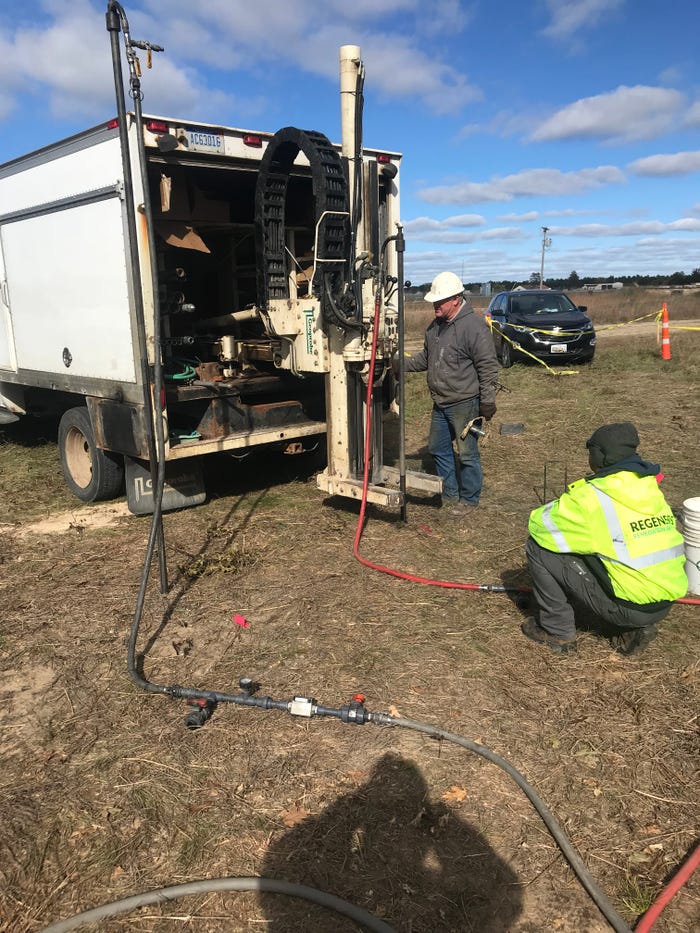In Situ PFAS Treatment Saves Money, Time, and Emissions
The REGENESIS team discovered that its system worked on PFAS when a consultant monitoring these compounds at a site where PlumeStop was treating petroleum-based contaminants got a surprise; the PFAS levels dropped. The technology was originally designed for other applications, namely chlorinated solvents and petroleum hydrocarbons.

Several years ago, environmental engineering firm Tetra Tech was called to Martha’s Vineyard Airport to remediate PFAS compounds identified in groundwater there, likely associated with aqueous film forming foam (AFFF) used onsite during firefighter training. The team set to work fast as there were drinking wells nearby; priority one was to prevent downgradient impact of these toxic chemicals.
They chose to run a pilot with a technology called PlumeStop that proved effective at remediating PFAS in groundwater at similar sites. It’s an activated carbon media system, which is no new concept for treating these complex, persistent compounds, but one facet sets PlumeStop apart; it’s applied in situ.
Developed by groundwater remediation technology company REGENESIS, the technology functions as an underground filter. Carbon is ground to minute-sized particles that are suspended in a polymer and injected into groundwater. An ultra-thin layer of carbon coats the soil, allowing water to flow through unimpeded while the contaminants attach to the activated carbon and ultimately become part of the soil matrix.
“PFAS is hard to break down and destroy. There are actually no technologies to break these compounds down in the ground, but we can stop them and keep them in place to protect downgradient receptors and reduce liabilities,” says Maureen Dooley, vice president of the Industrial Sector at REGENESIS.

Third-party testing shows PFOA and PFOS level reductions to 70 parts per trillion within three months, meeting state and proposed federal cleanup standards for groundwater.
More common PFAS-fighting approaches entail installing wells in the ground, extracting groundwater, and then treating it. But this methodology has its drawbacks.
Pumping contaminated water from underground generates more waste that must be landfilled or incinerated. These engineered systems must be maintained for decades. There are associated CO2 emissions, and extraction is an expensive undertaking.
“But because we directly inject the material into the subsurface, we are creating an underground filter, which is a cheaper system, and we are not generating waste that has to be managed later,” Dooley says.
PlumeStop is about 65% lower in cost than most groundwater extraction systems and has a 95% smaller footprint, she says.
The technology was originally designed for other applications, namely chlorinated solvents and petroleum hydrocarbons. But the REGENESIS team discovered quite by chance that their system worked on PFAS when a consultant monitoring these compounds at a site where PlumeStop was treating petroleum-based contaminants got a surprise; the PFAS levels dropped.
PlumeStop proved a good fit for the sandy aquifer at Martha’s Vineyard since the activated carbon media could be evenly distributed throughout the target area, which was confirmed through post-deployment drilling and sample collection.
The airport’s remote island location is also served well as costs to haul PFAS for disposal would be exorbitant, attests Ron Myrick, vice president at Tetra Tech.
The PlumeStop pilot has been deployed for about one year and the results have been impressive, Myrick says.
No PFAS has been detected in a groundwater monitoring well immediately downgradient of the PlumeStop treatment barrier, other than trace concentrations of a few unregulated PFAS.
Further downgradient, Tetra Tech is starting to see significant reductions in PFAS concentrations as treated groundwater continues to migrate through and beyond the barrier. Now the company is considering deploying the technology at other AFFF testing areas identified as PFAS sources.
“Based on one year of monitoring, the results have achieved the design criteria, and the project has been a success.” Myrick says.
In the evolving world of PFAS remediation, researchers are exploring destructive technologies, but they require tremendous energy and seem to have limited ability to manage high volumes of compounds.
The search for a cheaper efficient way has led some scientists down a path in reach of a bacteria to degrade PFAS. But this work is fairly nascent.
“So that’s the challenge – destroying it. And while it can be destroyed with a lot of energy the only applications are for drinking water,” Dooley says.
Treating PFAS in situ is hard because current options to destroy these compounds involve very high temperatures and high pressure, conditions that can’t be achieved underground.
PlumeStop has so far been applied at 25 sites specifically to tackle PFAS. Most interest is coming from airports, Department of Defense facilities, and some industrial properties near private residential wells, lakes, or waterways where liability is an issue.
From her front-line position Dooley observes many other responsible parties sitting on the sidelines for now.
But she, like others in her industry, anticipates that will change as more states heighten their scrutiny and as the federal government tightens its reigns. The U.S. Environmental Protection Agency could finalize national drinking water standards for several PFAS and designate two of them as hazardous substances in Q1 2024.
“If companies have discharges going offsite [regulators and other stakeholders] will look upstream to see where it’s coming from. And as more sites are identified they will be required to have remediation in place,” Dooley says.
About the Author(s)
You May Also Like




